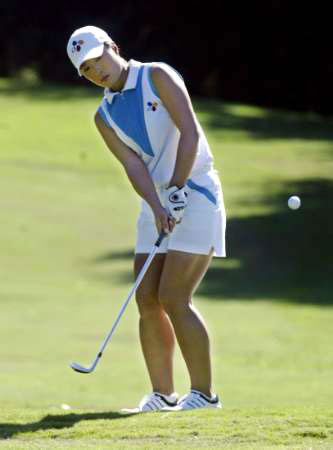 |
 |
 |
 |
 |
 |
In 2002, Se Ri had few bad finishes. But every time she missed the top 20, it was in an event after she had played a lot of events in a row. Her two worst finishes came at the Giant Eagle (her seventh event in 8 weeks) and the Williams (her fourth event in a row).
Se Ri expressed a wish to play in a men's event. Fine; but the scheduling of this event was terrible: right before the last four events of the year. This was always going to be a tough grind; two events in Asia, a quick trip to America, and two more events there. But add on to the front a men's event, which was so tough for her it was almost like an event and a half, and suddenly it looked very grim for her to have any chance to defend at the Mobile Tournament of Champions, the fourth event in the chain, or win the ADT, the fifth. Se Ri's pattern suggested it would be a struggle even to make the top ten at the TOC, which in fact was exactly what happened. If she insisted on doing the men's event, she should have skipped the Mizuno to give her a leg up on the field in Alabama and Florida. But her best bet, in terms of being the best *LPGA* player she can be, would have been to avoid the men's event entirely. Or at least play in one that did not interfere with important year-end events on her tour.

Although it was a gas, the men's event
she played last month really wore her out

Se Ri chips in round 1
Reuters/Tami Chappell
These events are proving to be especially important for her, since she has a chance to do something she has never done before. A win at either of the last two events would potentially give her the Vare Trophy, which in turn would give her the final Hall of Fame point she would need. In other words, Se Ri needs a win to become a Hall of Famer, but she set up her schedule to make it that much tougher that she could get one.
Adding to her troubles were the tough conditions in Mobile on the first two days. Thursday was particularly brutal. There would be no 20 under par performances on this course this year. Indeed, on day one, even a par was a great score. The last thing she needed after a long trans-Pacific flight (which was even longer for her because she missed her connection in Los Angeles) was a course where one lapse in concentration could cost you a huge score. Still, she played reasonably well through the first dozen holes. She only hit half her greens, but still managed two birdies and a bogey until the ninth hole, where one of the lapses occurred and she made a double bogey. The wind played havoc with club selection, and the greens were fast, meaning even if you got a green in regulation, you had no guarantee that a two or one putt was forthcoming.
One over par at that point was only a few shots out of the lead. But everything went to pot on a hole that should have jump started her tournament, the par 5 13th. She hit her drive well right into the trees, and her second failed to get out of the trees. In fact, it put her into so much trouble she needed to take an unplayable. So her fourth shot, still behind the trees, was still more than 200 yards from the hole. She punched it nicely out to 50 yards. The situation reminded me of the one at the men's event, where Se Ri had hit her second shot into the water. Left with a wedge on her fourth, she stuck it to two feet and saved bogey. She had a chance to do that here, but the wind was not going to cooperate, and she overshot the hole by 15 feet. Her first putt was not close, and her second lipped out. And just like that, she had a triple bogey, and plummeted to 4 over par, where she would finish the day after another birdie and bogey. An 8. Not often you see one of those on Se Ri's scorecard. Still, Se Ri was only six shots out of the lead, and only two players had even managed to break par. But she would need to find energy somewhere to make a move.

Se Ri drives it in round 1
Reuters/Tami Chappell